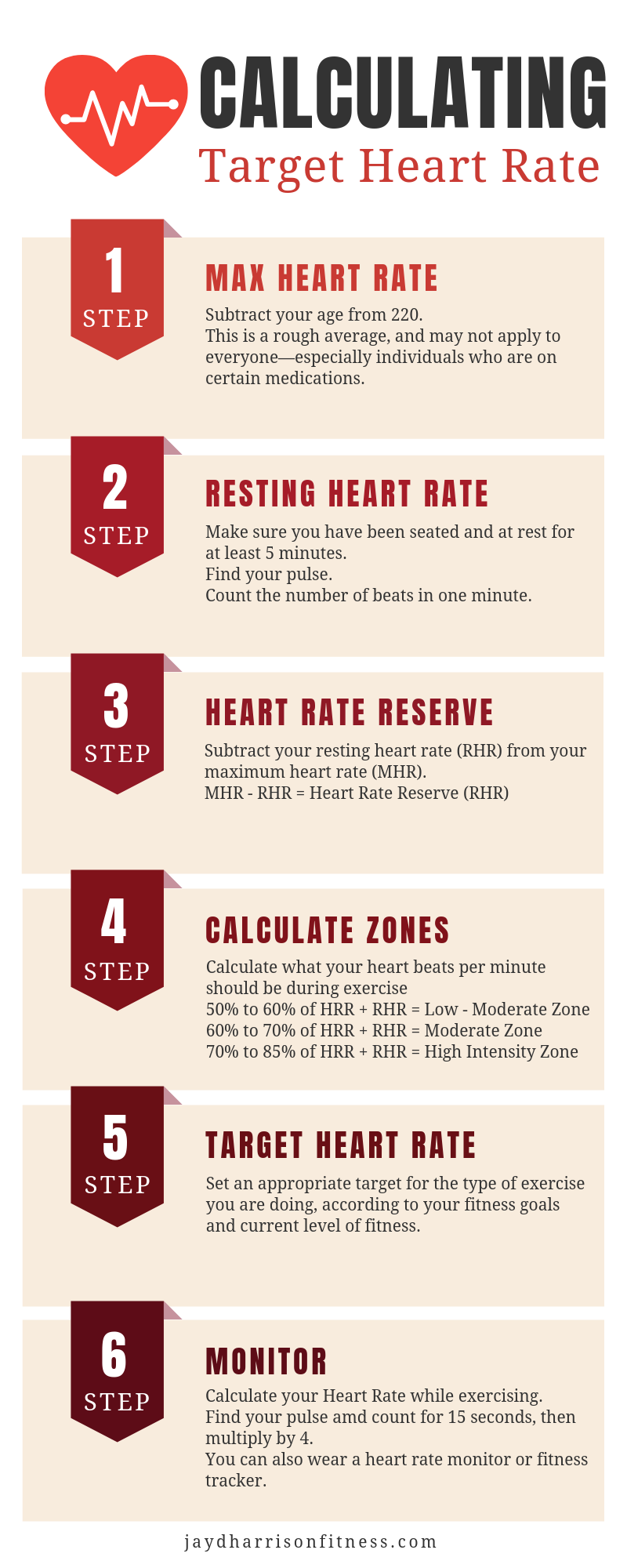Using Target Heart Rate to Monitor Exercise
How hard should you push yourself to get the most out of your workouts?
In order to enjoy safe & effective workouts and get the most benefits, it’s important to monitor how hard you are working during exercise.
Target Heart Rate (THR)
Target Heart Rate (THR) is a tool to help you to set goals for your exercise intensity, and is most often used as a measurement in cardiovascular exercise (as opposed to strength training—although it certainly can be useful in strength training, as we’ll discuss below).
Your THR is the recommended number of beats per minute that a healthy heart in a person of your age and gender should have for certain exercise intensities.
Exercise scientists recommend that individuals work out at an intensity that is between 50% and 85% of their Heart Rate Reserve (HRR) to get the most benefits out of cardiovascular exercise.
Your THR will vary depending on the type of exercise you are doing and your goals for that activity.
For example, you would in general benefit more from a higher target heart rate during cardiovascular exercise—where the goal is to improve the fitness of your heart and lungs—than you would during strength training.
Although there is some cardiovascular benefit to strength training (your muscles need your heart to supply oxygen as they push their load), the goal here is to build muscle. This requires rest and recovery periods in which you may do little to no activity, and your heart rate may not be as elevated during these periods. During a strength training session, you’ll see your heart rate fluctuate and drop down towards resting below the 50% mark, whereas in a cardio workout we like to maintain a heart rate of at least 50% of heart rate reserve.
In a cardio modality like High Intensity Interval Training (HIIT), you’ll also see a fluctuation in heart rate between higher intensity zones (70-85%) and lower intensity zones (50-70%), but the goal is, again, to sustain the heart rate within that 50-85% target range.
The Target Heart Rate of your workout also depends on your current level of fitness. For example, I would recommend a de-conditioned individual with a sedentary lifestyle begin by walking for their cardiovascular exercise with a target heart rate range of between 50% and 65% of their heart rate reserve (a relatively low to moderate intensity level). An athlete on the other hand—such as a boxer preparing for a fight— would need to spend more time at a higher range during her or his cardiovascular training (between 60% and 85% of their HRR).
One way that heart rate can be used during strength training is to help you track your rest periods. For example—rather than setting a period of time for your rest (such as 1 - 3 minutes), you can say “I’ll do my next set once my heart rate drops back down to 50%.”
Keep in mind that certain health conditions and medications can affect your heart rate—either causing it to be abnormally high or low. Some people also just naturally have higher or lower heart rates than the average—and this must be taken into account. If you have an abnormally low or high heart rate, you may be better off using the Talking Test or Perceived Rate of Exertion to monitor exercise intensity.
How to Calculate Target Heart Rate
Step 1. Calculate Maximum Heart Rate (MHR)
Subtract your age from 220 to get your maximum heart rate.
Step 2. Calculate Resting Heart Rate (RHR)
Make sure you have been seated and at rest for at least 5 minutes before calculating your RHR. Keep in mind that the best time to measure RHR is as soon as you wake up in the morning.
Find your pulse either at your radial artery on the thumb side of your wrist or on your neck to the side of your windpipe. Use your index and middle fingers rather than your thumb (your thumb has its own pulse).
Set a timer for 1 minute, and count the number of times you feel your heart beat during that time. Record that number as your Resting Heart Rate (RHR)
Step 3. Calculate Heart Rate Reserve (HRR)
Subtract your resting heart rate (RHR) from your maximum heart rate (MHR). Your HRR is that number.
Step 4. Calculate Exercise Intensity Zones
Now to get the different zones of Exercise Intensity, you will need to calculate the various percentages of your HRR and add back in your resting heart rate:
50-60% HRR + RHR = Low to low-moderate Intensity
60-70% HRR + RHR = moderate intensity
70-85% HRR + RHR = moderate high to high intensity
Your target heart rate may be to work at a lower intensity (50-60%) or higher (up to 85%), depending on the type of exercise you’re doing, your goals, and your current level of fitness.
About the Author
Jayd Harrison is a personal trainer and streamer on Twitch.tv/Jaydigains. She helps clients to find their strength and work towards healthier lifestyles through personal training, group classes, and health coaching.

